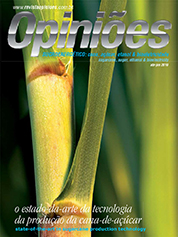Raffaella Rossetto
Technical Director of Divisão APTA
Op-AA-24
Progress in sugarcane production technology: residues or sub-products?
In reflecting about progress in technology in the field of residue use for sugarcane nutrition, one can observe that albeit residues continue to be practically the same, produced in larger quantities, many concepts about their use and importance have changed. The big change is in tune with sustainability, according to which, concept recycling and less generation in the process are added to previously seldom observed concepts, such as possible environmental contamination resulting from inadequate use, lixiviation of ions or greenhouse gas emissions.
No doubt the environmental issue can no longer be separated from the agricultural issue, so that their co-existence becomes necessary. In recent years, we also witnessed oscillations with unexpected highs in international fertilizer prices. We might add that Brazil is highly dependent on fertilizer imports and that this market is dominated by few exporting countries, in what is a situation similar to the fragile oil market. Even in making large investments we would not attain autonomy in fertilizer production and the dependence on imports, mainly of potassium, would endure for many years.
In this context, residues achieved a higher “status”. We ceased (or should have ceased) treating them as residues, in the sense that their value as an alternative source to fertilizers grew in importance and economic value. Their “status” also increased in view of environmental requirements. To recycle residues and nutrients scores positively in the industry’s Sustainability Reports or in terms of organic certification requirements.
Sugarcane plantations have a peculiarity that sets them aside from most agricultural commodities: products exported in the agro-industrial system – sugar and ethanol – only contain the elements C, H, and O, i.e., mineral nutrients used in the crop’s production can be recycled and remain in the system.
Due to extensive production areas, residue generation in the sugarcane industry is, in itself, impressive. However, due to the high aggregate value, residues could become raw materials for other agricultural and industrial activities, such as bagasse, which for a long time has been considered an important sub-product in energy generation. New second generation ethanol co-generation and production technologies further increased their aggregate value.
The same may occur with straw. In this case, the challenge is to obtain it in the fields without adversely affecting its agronomic advantages, which are beneficial if it is used to cover the ground. Filter cake has a high agronomic value because it contains nutrients and also due to its high content of organic material, easily decomposable.
One considers that 50% of phosphorous and nitrogen are quickly supplied to sugarcane. The other half stubbornly stays in the organic material, forming a reserve and contributing to improve fertility and to warrant sustainability. Innovations in the use of filter cake occurred when adopted on a larger scale in compostation, which can be done by adding other residues such as soot, plaster, vinhasse, leftovers from other crops, animal dung, or other sources of nutrients, whereas one should check out the interest and the economics of mixing such material to the cake.
Agricultural machines and accessories were developed to revolve the furrows, to allow for easier compostation. An innovative system is used by Usina São Martinho, in the State of São Paulo, in which a part of the cake is buried in grooves before compostation is complete, in the reform areas, months in advance of the planting.
When the time for planting comes, the grooves are opened in the same place and the cake will already have decomposed, thus facilitating operations and avoiding the need for large compostation yards. Of the several alternatives for use of vinhasse, the most economic and efficient from the agricultural point of view is fertirrigation of sugarcane plantations.
The novelties with respect to the use of vinhasse developed along several lines: one refers to new irrigation techniques, such as the use of linear irrigation, lateral and central irrigation pivots and sub-surface dripping, aiming at achieving lower costs, less losses and improved applications. Another aspect refers to environmental legislation, which in the case of São Paulo, limited doses used according to soil analyses and existing content of K.
This legislation seeks to prevent possible environmental contamination risks by lixiviation with ions. As a conse-quence, in order to reduce transportation costs, investments are made in vinhasse concentration, maintaining the residue’s agronomic quality. The production of pelletized organic fertilizer from dry vinhasse and added to the filter cake, along with other mineral nutrients, may be an option for preserving vinhasse and a recommendable agronomic practice.
With sustainability concepts increasingly anchored in the industry’s day-to-day and with the resulting demands concerning environmental impacts, a major impulse has been given to companies’ environmental management, for them to invest in capacitation. Nowadays, it is common for a mill to have a department exclusively dedicated to residue use management and its applications in the environment, promoting adequate agronomic and environmentally correct use.
What is to be expected in coming years? It is possible that environmental legislation may become more re-strictive. And how about our responsibility as agronomists, or our awareness as citizens? Will we be in synchronization with the new age? Will we be able to definitively abolish the word “residues” and treat them merely as sub-products?




